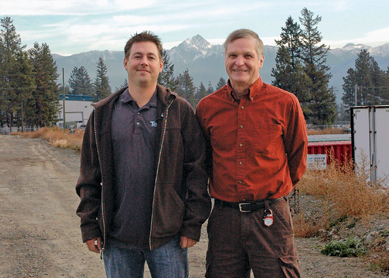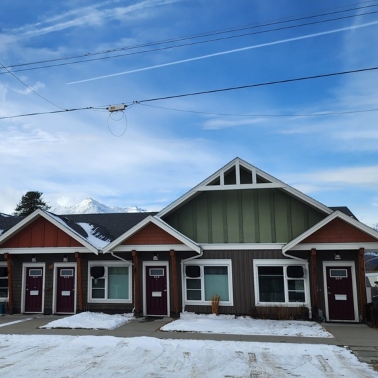From the ground up
CABBDA wants to spread the message that new, sustainable developments attract new residents and create economic activity

(L to R) Sheldon Isaman and Dennis Hockley believe that most residents of Cranbrook want the same thing—sustainable, economic growth that will keep families living and working in the area; new construction provides employment and affordable housing. — Tanya Laing Gahr photo
If you build it, they will come. That’s not just a great line from a pretty good movie, it’s also the philosophy and expectation of most business people. And a newly formed group of builders and developers in Cranbrook are counting on just that to promote sustainable growth in the city.
The Cranbrook & Area Business, Builders & Developers Association (CABBDA) is only a few months old—but its chair, Dennis Hockley, and one of the CABBDA board directors, Sheldon Isaman, are hoping the organization will be a part of shaping long-term plans for growth in Cranbrook.
CABBDA was formed by a number of builders and developers in the city who felt there was a need for a united voice to address industry and public concerns, provide input for city planners and referrals for members. The group also promotes the fact that the development sector—because it provides millions of dollars in spinoff businesses—is vital to the economic growth and sustainability of a community. The organization took its lead from the Fernie Area Builders and Developers Association, which has provided support to CABBDA.
“(The purpose) is really to inform, educate and advocate on behalf of the industry with the public,” said Isaman, who has been a developer in the area for more than 15 years. “We are a fairly new group but we are talking about doing some workshops because I don’t think a lot of people really understand our industry.”
Isaman made it clear that CABBDA is not seeking to take the place of established business advocacy organizations such as the Cranbrook & District Chamber of Commerce, though it has invited members of the Cranbrook business community to be a part of the association.
“We want to work in unison with (the chamber) on certain things,” he said. “We’ve talked about bringing in some guest speakers who are of mutual benefit. We’ve had some discussions that a director from the chamber board would have an advisory role on our board that might be reciprocal.”
One of CABBDA’s mandates will be to act as a central point of contact for new builders and developers who may be seeking opportunities in the region, as well as for the City or other organizations to communicate with the various businesses CABBDA representatives. With a vast number of professionals directly or indirectly represented by CABBDA’s membership, the association will also act as a hub for industry resources.
“We have some experts with a lot of experience working in different areas,” said Hockley, who is a developer and business owner originally from Cranbrook, “so we are now able to sit down with the City and go through (proposed) bylaws step-by-step, say what works and offer some advice and some solutions to their problems. We realize that we might not agree on everything, but at least we can work on some common ground (and) work well with the City.”
Indeed, agreement isn’t necessarily the goal. Mutual understanding is.
In recent months, since last year’s East Hill referendum (see Kootenay Business, November/December 2009, A Question of Growth), Cranbrook has remained at odds over the issue of growth. The city’s development and building sector has taken hits with suggestions that it values money and expansion over sustainability and small-town values. But Isaman said that as he has communicated more with those who opposed the City’s bid to expand the land base, he has found that the goals of seemingly opposing groups are more similar than not.
The most common goal is sustainability, which, Isaman said, must pass the four-pillar litmus test for addressing growth: economic, cultural, social and environmental. He cautions that in order for a development, building or business to be sustainable, it must also be attainable—and that means being aware of all of the costs as well as the demand.
“I’ve heard from a lot of people (that we should) go up instead of out,” he said. “That’s great in theory but it’s also expensive to go up. Concrete is still very costly, even in this economy. We need to educate people that there are ways to develop sustainability. You don’t have to have sprawl but there is something in between that will keep people happy.”
CABBDA is not intended to be a political group, but Hockley said that as the organization grows and receives direction from its membership, he hopes to invite political candidates to forums to address issues that are important to the industry.
“A few years ago there was a statement that Cranbrook was closed for business,” said Hockley, “(but) the city fathers are working very hard to say that Cranbrook is open for business, and we want to promote that and work with the people who would promote that—not people who want to close down the city but those who look at new business to come forth.”
One aspect of Cranbrook’s planning on which most citizens can agree is a need to create a strong economy that encourages families to relocate here and stay. The Canadian Rockies International Airport expansion and upgrades at the East Kootenay Regional Hospital have helped make the city more attractive for an aging population. But without available and attractive career opportunities for young people, Cranbrook’s fortunes are limited.
“Our hope is that our families can stay here and work here and not have to go to the larger cities,” said Hockley. “We’re all family people and this is where we want our families to stay—or at least have that opportunity. We want to do what we can to promote this city as a place to live and work.”
Building a Kootenay coalition
Michael Delich, the chair of the Fernie Area Builders and Developers Association (FABDA), said advocacy on behalf of the industry is one of the main purposes of the organization. But that’s only the beginning.
“What we wanted to do—our first step—was to ensure that all individuals and businesses were sharing the same data and/or information and that we were talking on that same data and information,” said Delich. “And after the dialogue, we would have policy. What our organization wanted to do was raise the awareness of our industry, but at the same time raise the professionalism. We have a lot of very respected builders and developers that have been operating in Fernie for over 20 years and what we wanted to do was share that in the community.”
FABDA has been successful in creating a cohesive message, encouraging community dialogue and bringing to town respected speakers such as Dianne Watts, the mayor of Surrey, B.C. This, in turn, has a number of loosely associated builders and developers across the East Kootenay considering forming a larger alliance to spread awareness about the industry throughout the region.
“What we want to do is continue building because I think all small communities have the same issues of working and (wanting to be) understood and establishing best practices such as building green,” said Delich. “So it’s very, very positive.”





Comments